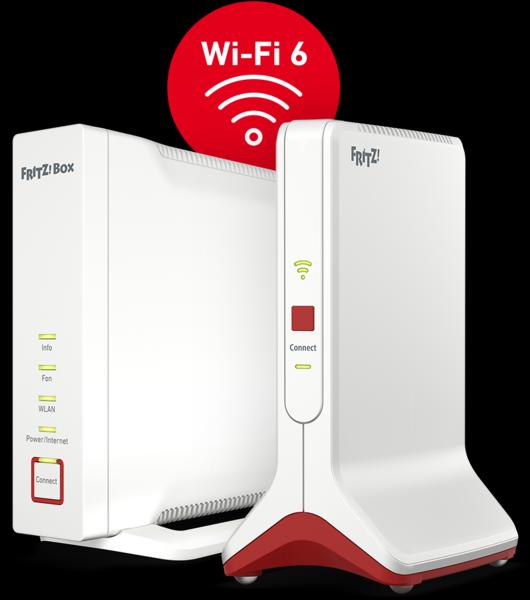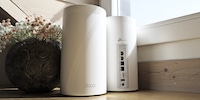

AVM mesh Wi-Fi speed test: Fritz!Box 4060 and Fritz!Repeater 6000
The Fritz!Box 4060 and the Fritz!Repeater 6000 get to prove how much signal strength and speed they deliver in my two-story apartment. Will AVM manage to push the previous test winners by TP-Link and Netgear from their thrones with their Fritzes?
AVM Fritz!Boxes are available with or without a modem. I’m testing a model without. In other words, a pure Wi-Fi router. The Fritz!Box 4060 to be precise. It’s joined by the Fritz!Repeater 6000, a pure satellite for expanding the Wi-Fi. Both products feature the Wi-Fi 6 standard and enable a mesh system that can be supplemented with additional repeaters. I’m testing the Fritz system for speed, latency and signal strength in my two-story apartment. I’m comparing the results with the competition.
AVM kindly provided me with both products for my test.
CH

DE
One of the Fritz!Box’s special features is the integrated DECT base to make phone calls. It’s also equipped with a media server and network storage function (Fritz!NAS).
Both test products are also available for purchase individually or in other bundles. Find corresponding offers here.
Hardware und features
In a mesh system, each access point sets up its own Wi-Fi. In other words, mesh-enabled repeaters don’t just forward a radio signal like they used to do. This results in greater reach, reduced delays and more data throughput.
The connection between the two mesh network devices is handled by a third band, which is located in the 5 GHz frequency range. To achieve a stable connection, it’s usually enough to place the repeater on the target floor roughly above or below the router. If you want a better connection, some mesh products can also be connected with a long network cable.
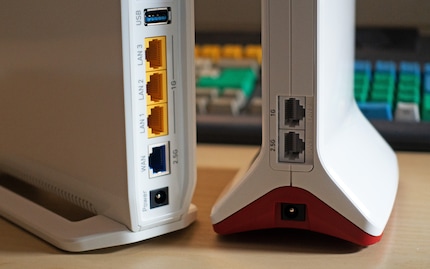
Both test devices have a 2.5 Gigabit RJ45 port and three or one Gigabit LAN port, respectively. They’re also capable of establishing a connection via a cable. This is also referred to as backhaul. However, I won’t include this in my tests. Instead, I’ll focus on the purely Wi-Fi-based mesh. The range of comparable products out there keeps growing and they’re becoming increasingly difficult to beat. After all, despite ever-evolving Wi-Fi standards, it’s primarily the physical conditions that are responsible for strong Wi-Fi – think processor, RAM and especially the number of antennae and their design. This won’t be changed much either by Wi-Fi 7 due next year.
The mesh system’s specs:
| FRITZ!Box 4060 | FRITZ!Repeater 6000 | |
|---|---|---|
| Ports: | 1 × RJ45 2,5-Gigabit, 3 × RJ45 Gigabit, 1 × USB-A 3.0 | 1 × RJ45 2,5-Gigabit, 1 × RJ45 Gigabit |
| 2.4 GHz standards: | IEEE 802.11ax/n/g | IEEE 802.11ax/n/g |
| 5 GHz standards: | IEEE 802.11ax/ac/n/a | IEEE 802.11ax/ac/n/a |
| 2.4 GHz gross speed: | up to1,200 Mbps | up to 1,200 Mbps |
| 5 GHz gross speed: | up to 2,400 Mbps | up to 2,400 Mbps |
| 5 GHz gross speed – third band: | up to 2,400 Mbps | up to 2,400 Mbps |
| Operating mode: | (Mesh) router, IP client | Mesh repeater |
| Encryption and security: | WPA3-Personal, WPA2-Personal, SPI Firewall, Wi-Fi Protected Setup (WPS),VPN (IPSec) and more | WPA3-Personal, WPA2-Personal, Wi-Fi Protected Setup (WPS) and more |
| Features: | Mesh Wi-Fi router Wi-Fi 6 standard, tri-band, beamforming, 4×4 MU-MIMO, OFDMA, guest network, UPnP, DECT base for phone calls (up to 6 devices), media server, FRITZ!NAS and more | Mesh Wi-Fi extension Wi-Fi 6 standard, tri-band, beamforming, 4×4 MU-MIMO, OFDMA and more |
| Operation: | Connect button | Connect button |
| Dimensions: | 8,1 × 21 × 17 cm, 512 g | 8,7 × 18,5 × 13,5 cm, 370 g |
Setting it up
Setting up the new mesh is simple as always and no different to other manufacturer’s:
- Connect router with power cable
- Connect router to modem via RJ45 cable over WAN port
- Start up your notebook or get your smartphone out and log into the preset Wi-Fi. A card with SSID and password is included for this purpose. A QR code is also available for easy setup via smartphone.
- Use the password printed onto the card to log into a browser at http://fritz.box and follow the instructions.
The fritz.box URL automatically redirects you to the port of your Fritz!Box. Once you’ve logged in and completed the initial setup, you can let loose in the web interface called Fritz!OS. I find the menu structure and operation of the OS logical and well organised. I’m not missing any features. For example, the automatic port forwarding for my Synology-NAS are created in no time.
To connect the repeater to the router, I first connect it to the power. I wait for a bit until it’s started up and the LED connect button flashes slowly. Then I press this button, which makes the LED flash quickly. After pressing the same button on the router, the devices are connected. A further Wi-Fi icon LED tells you how good the connection quality is. In my case, it’s green, which means the connection is good. Orange stands for a weak connection. Flashing orange means the connection is interrupted.
Apartment floor plan and router location
I set up the two Fritzes in my flat in the same places where corresponding devices were located during my previous mesh Wi-Fi speed tests. I set up the router in the upper attic of my 140-m² maisonette near the most central power socket. The repeater is placed on the floor below in the entrance area. This offered the best signal strength for the device on the lower floor from the one above – allowing for the ideal radio backhaul between both nodes. A signal has to make its way through the flat, past floor heating and reinforced concrete.
Speed, ping and signal strength per room
New Wi-Fi needs a little time to develop its full performance. That’s why I always give it at least three days before starting my tests. For testing, I use a notebook that supports the respective Wi-Fi standard. Previously, I’d use an Asus notebook with Wi-Fi 6. These days I’m using a futureproof Lenovo notebook with Wi-Fi 6E.
To test the new mesh system, I use the «NetSpot» software to determine the signal strength. The signal level heatmaps shown below were also generated with the help of this software. To measure latency, I ping my NAS. I determine download speeds by operating my NAS. All measurements are taken at the same 37 points in my flat, as always. They can be seen in the map below.
Results
The Fritz mesh performs as follows:
| Location | 5 GHz frequency band
speed / ping / signal strength | 2.4 GHz frequency band
speed / ping / signal strength |
|---|---|---|
| Entrance | 657,47 Mbps / 8 ms / -48 dBm | 151,55 Mbps / 9 ms / -39 dBm |
| Living room | 464,38 Mbps / 10 ms / -63 dBm | 134,06 Mbps / 12 ms / -55 dBm |
| Dining area | 510,03 Mbps / 9 ms / -63 dBm | 139,88 Mbps / 11 ms / -53 dBm |
| Kitchen | 634,47 Mbps / 9 ms / -57 dBm | 145,51 Mbps / 10 ms / -47 dBm |
| Balcony | 27,29 Mbps / 16 ms / -80 dBm | 100,49 Mbps / 15 ms / -67 dBm |
| Room 1 | 516,73 Mbps / 9 ms / -62 dBm | 131,87 Mbps / 10 ms / -53 dBm |
| Bathroom | 525,70 Mbps / 9 ms / -59 dBm | 143,12 Mbps / 11 ms / -54 dBm |
| Hallway | 720,35 Mbps / 3 ms / -43 dBm | 128,33 Mbps / 10 ms / -50 dBm |
| Room 2 | 575,05 Mbps / 4 ms / -57 dBm | 101,11 Mbps / 11 ms / -64 dBm |
| Room 3 | 766,85 Mbps / 3 ms / -38 dBm | 138,56 Mbps / 8 ms / -45 dBm |
| Room 4 | 667,34 Mbps / 4 ms / -50 dBm | 131,40 Mbps / 11 ms / -53 dBm |
| Shower/WC | 672,56 Mbps / 4 ms / -54 dBm | 132,94 Mbps / 11 ms / -58 dBm |
| Ø 1. upper floor | 476,58 Mbps / 10 ms / -62 dBm | 135,21 Mbps / 11 ms / -53 dBm |
| Ø 2. upper floor | 680,43 Mbps / 4 ms / -48 dBm | 126,47 Mbps / 10 ms / -54 dBm |
| Ø apartment | 561,52 Mbps / 7 ms / -56 dBm | 131,57 Mbps / 11 ms / -53 dBm |
In the 5 GHz frequency band, which offers more data throughput, the Fritz Mesh delivers peak values of up to 766.85 Mbps. That’s in room 3, where the router is located. That’s 95.86 millimetres per second. On average, I get 680.43 Mbps on the upper floor. Looking to the lower floor and the connection quality between the two nodes, I’m very happy. The entrance area gets 657.47 Mbps. Except for the balcony, all rooms are well served, resulting in an average of 476.58 Mbps. In addition, the signal strength on the balcony is so weak that I only have reception with my notebook – it’s not even enough for my smartphone. Viewed over the entire apartment, the Fritz mesh delivers 561.52 Mbps. It’s the third-best result ever achieved, as the comparison with the competitors below shows.
In the 2.4 GHz frequency band, which has a greater reach with the same transmission power but offers less data throughput, AVM only performs average with 131.57 Mbps over the entire apartment. It’s worth mentioning that the repeater on the lower floor performs better than the one on the upper floor. This is atypical and nothing I’ve come across before. Nonetheless; thanks to 2.4 GHz I can surf, plex and Netflix with all end devices – even on the balcony.
The response time a signal needs to find its way from a laptop to the NAS and back – ping – is outstanding on the upper floor at 5 GHz and only takes four milliseconds. However, around five milliseconds are lost on the way to the lower floor, which raises the apartment’s average to seven milliseconds. At 2.4 GHz, the latency averages eleven milliseconds.
Visualising the 5 GHz Wi-Fi coverage
Signal strength is measured in decibel milliwatts (dBm). Excellent values are -35 to -50 dBm. Good ones are -60 dBm. Things start to get critical for many devices from -70 dBm. Anything under -80 dBm means it’s game over in most cases.
In the following heatmaps, the signal coverage is visualised in colour. It clearly shows where the signal struggles to reach: all areas that are bluish. The Fritz mesh delivers an average of -56 dBm at 5 GHz. At -80 dBm, there’s only too little reception on the balcony. Apart from this problem zone, the 5 GHz frequency band performs okay on the lower floors and flawlessly on the upper floors – everything is red, yellow or green there.

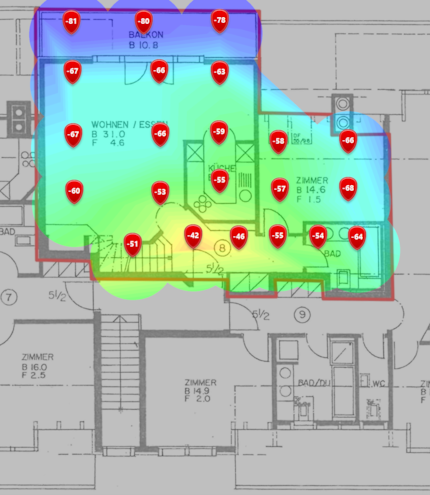
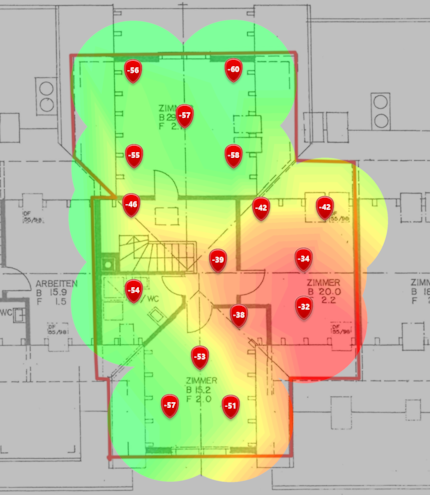
Visualising the 2.4 GHz Wi-Fi coverage
At 2.4 GHz, the average is -53 dBm and reception just about good enough to use the internet on all devices. Even on the balcony. The Fritz!Box 4060’s weaker frequency band performance compared to the Repeater 6000 can be seen quite well on the heatmaps. For example, the entrance area with the repeater is atypically coloured redder than room 3, where the router is located. In room 2 on the upper floor, the signal is also clearly worse than in the 5 GHz frequency band.

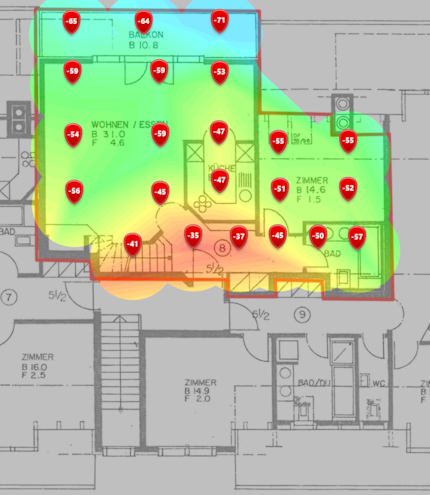
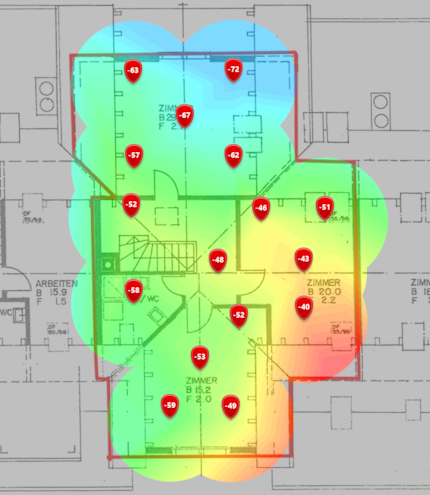
Comparing with the competition
Comparing the mesh systems tested in this apartment so far reveals that AVM delivers a good result. Only TP-Link’s Deco-X90-Mesh and Netgear’s Orbi AX6000 manage more speed and lower latency in the 5 GHz frequency band. However, the signal coverage of the Fritz Mesh is slightly ahead of Netgear’s.
In the 2.4 GHz frequency band, the Fritz Mesh is the joint winner with TP-Link’s in terms of signal strength. Having said that, it ends up in last place in the ping measurements. The speed is in the midfield.
The 5 GHz comparison:
| Mesh Wi-Fi system | Ø Apartment 5 GHz frequency band
speed / ping / signal strength |
|---|---|
| TP-Link mesh: Deco X90
(Wi-Fi 6, 2 access points) | 631,31 Mbps / 5 ms / -55 dBm |
| Netgear mesh: Orbi AX6000
(Wi-Fi 6, 2 access points) | 629,64 Mbps / 5 ms / -58 dBm |
| AVM mesh: FRITZ!Box 4060
+ FRITZ!Repeater 6000 (Wi-Fi 6, 2 access points) | 561,52 Mbps / 7 ms / -56 dBm |
| Linksys mesh: Velop AX4200
(Wi-Fi 6, 2 access points) | 525,23 Mbps / 7 ms / -54 dBm |
| Swisscom mesh: internet box 3
+ WiFi box 2 (Wi-Fi 6, 2 access points) | 482,14 Mbps / 3 ms / -55 dBm |
| Asus mesh: ZenWiFi AX6600
(Wi-Fi 6, 2 access points) | 467,36 Mbps / 3 ms / -57 dBm |
| Devolo mesh: Magic 2 WiFi 6
(Wi-Fi 6, 3 Powerline-access points) | 220,15 Mbps / 6 ms / -62 dBm |
| Devolo mesh: Mesh WiFi 2
(Wi-Fi 5, 3 powerline access points) | 214,44 Mbps / 6 ms / -60 dBm |
The 2.4 GHz comparison:
| Mesh Wi-Fi system | Ø Apartment 5 GHz frequency band
speed / ping / signal strength |
|---|---|
| TP-Link mesh: Deco X90
(Wi-Fi 6, 2 access points) | 255,72 Mbps / 5 ms / -53 dBm |
| Linksys mesh: Velop AX4200
(Wi-Fi 6, 2 access points) | 150,82 Mbps / 7 ms / -59 dBm |
| Asus mesh: ZenWiFi AX6600
(Wi-Fi 6, 2 access points) | 139,77 Mbps / 3 ms / -56 dBm |
| AVM mesh: FRITZ!Box 4060
+ FRITZ!Repeater 6000 (Wi-Fi 6, 2 access points) | 131,57 Mbps / 11 ms / -53 dBm |
| Netgear mesh: Orbi AX6000
(Wi-Fi 6, 2 access points) | 128,53 Mbps / 5 ms / -54 dBm |
| Devolo mesh: Magic 2 WiFi 6
(Wi-Fi 6, 3 powerline access points) | 128,09 Mbps / 7 ms / -59 dBm |
| Devolo mesh: Mesh WiFi 2
(Wi-Fi 5, 3 powerline access points) | 126,70 Mbps / 7 ms / -57 dBm |
| Swisscom mesh: internet box 3
+ Wi-Fi box 2 (Wi-Fi 6, 2 Zugangspunkte) | 117,26 Mbps / 4 ms / -59 dBm |
Verdict: solid mesh system with a large range of features
AVM and its two Fritzes win the bronze medal in this apartment’s mesh test series with an average of 561.52 Mbps in the 5 GHz frequency band. I like that and am also somewhat surprised, given the fact that both devices are on the small side and sport a plain design.
There’s room for improvement when it comes to reception on the balcony. However, this is a common problem in other systems that circumnavigate the 2.4 GHz frequency band. And yet, I still have a bit complaining to do. Apart from the 5 GHz frequency band on the upper floor, the ping measurements yield the lowest I’ve measured so far in both frequency bands. Keep in mind that I’m talking about a few milliseconds of difference, which is only important for pro gamers.
All in all, the Fritz!Box and the repeater offer many features in addition to a good Wi-Fi performance. In addition to the standard router options, there’s also the DECT base, the media server and the Fritz!NAS. I also think the devices are good in terms of value for money and can recommend them.
Want to find out how the Fritz!Box 4060 performed as a standalone device in my colleague Jan Johannsen’s home? Read his review here:
I find my muse in everything. When I don’t, I draw inspiration from daydreaming. After all, if you dream, you don’t sleep through life.
